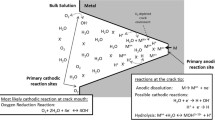Abstract
A general method to predict the crack propagation of anodic dissolution corrosion fatigue is developed in this paper. Crack propagation of corrosion fatigue is presented as the result of the synergistic interactions of mechanical and environmental factors, and corrosive environment accelerates crack propagation mainly in term of anodic dissolution. By studying the variation of mechanical energy and electrochemical energy of anodic dissolution during the crack propagation process, an explicit expression of crack propagation rate is derived by the conservation of energy. The comparisons with experimental data demonstrate the validity of the proposed model. Moreover, the applicable upper-limit crack length for steady crack propagation is determined and the crack propagation life is evaluated.
Similar content being viewed by others
References
Bhuiyan M S, Mutoh Y, Murai T, et al. Corrosion fatigue behavior of extruded magnesium alloy AZ61 under three different corrosive environments [J]. International Journal of Fatigue, 2008, 30(10–11): 1756–1765.
Ebara R. Corrosion fatigue crack initiation behavior of stainless steels [J]. Procedia Engineering, 2010, 2(1): 1297–1306.
Ishihara S, Nan Z Y, McEvily A J, et al. On the initiation and propagation behavior of corrosion pits during corrosion fatigue process of industrial pure aluminum [J]. International Journal of Fatigue, 2008, 30(9): 1659–1668.
Zupanca U, Grumb J. Effect of pitting corrosion on fatigue performance of shot-peened aluminium alloy 7075-T651 [J]. Journal of Materials Processing Technology, 2010, 210(9): 1197–1202.
Gao M, Pao P S, Wei R P. Chemical and metallurgical aspects of environmentally assisted fatigue crack growth in 7075-T651 aluminum alloy [J]. Metallurgical and Materials Transactions A, 1988, 19(7): 1739–1750.
Schroeder V, Gilbert C J, Ritchie R O. Effect of aqueous environment on fatigue-crack propagation behavior in a Zr-based bulk amorphous metal [J]. Scripta Materialia, 1999, 40(9): 1057–1061.
Kim Y H, Fine M E. Fatigue crack initiation and strain-controlled fatigue of some high strength low alloy steels [J]. Metallurgical and Materials Transactions A, 1982, 13(1): 59–72.
Wang R. A fracture model of corrosion fatigue crack propagation of aluminum alloys based on the material elements fracture ahead of a crack tip [J]. Engineering Fracture Mechanics, 2008, 30(8): 1376–1386.
Zhao WM, Xin R F, He Z R, et al. Contribution of anodic dissolution to the corrosion fatigue crack propagation of X80 steel in 3.5 wt.% NaCl solution [J]. Corrosion Science, 2012, 63: 387–392.
Shen Hai-jun, Lü Guo-zhi. Effect of anode dissolution on corrosive fatigue crack propagation [J]. Journal of Northwestern Polytechnical University, 2001, 19(2): 225–228 (in Chinese).
Menan F, Henaff G. Influence of frequency and exposure to a saline solution on the corrosion fatigue crack propagation behavior of the aluminum alloy 2024 [J]. International Journal of Fatigue, 2009, 31(11–12): 1684–1695.
Engelhardt G R, Macdonald D D. Modelling the crack propagation rate for corrosion fatigue at high frequency of applied stress [J]. Corrosion Science, 2010, 52(4): 1115–1122.
Meng G Z, Zhang C, Cheng Y F. Effects of corrosion product deposit on the subsequent cathodic and anodic reactions of X-70 steel in near-neutral pH solution [J]. Corrosion Science, 2008, 50(11): 3116–3122.
Chun Y G, Pyun S I. Crack closure in the fatigue crack propagation of a Cu-2wt.%Be alloy in dry air and ammoniacal solution [J]. Materials Science and Engineering A, 1996, 206(1): 49–54.
Da Fontea M, Romeirob F, De Freitasc M, et al. The effect of microstructure and environment on fatigue crack propagation in 7049 aluminium alloy at negative stress ratios [J]. International Journal of Fatigue, 2003, 25(9–11): 1209–1216.
Gangloff R P. Crack size effects on the chemical driving force for aqueous corrosion fatigue [J]. Metallurigical and Materials Transaction A, 1985, 16(5): 953–969.
Wang Rong. Corrosion fatigue of metal material [M]. Xi’an: Northwestern Polytechnical University Press, 2001 (in Chinese).
Lu Min-xu, Zheng Xiu-lin, Qin Xiong-pu. Progress in research of model of mechanics-chemical interaction in corrosion fatigue [J]. Journal of Chinese Society of Corrosion and Protection, 1991, 11(2): 197–208 (in Chinese).
Nguyen O, Repetto E A, Ortiz M, et al. A cohesive model of fatigue crack growth [J]. International Journal of Fracture, 2001, 110(4): 351–369.
Liu Jing-jing, Sun Jun-jun, Hu Hai-yun, et al. The life prediction for materials under the corrosion of seawater [J]. Acta Physica Sinica, 2005, 54(5): 2414–2417 (in Chinese).
Han Bin, Xing Xiu-san. Stability analysis of a twodimensional dislocation crack model [J]. Acta Mechanical Sinica, 1997, 29(2): 224–230 (in Chinese).
Xing X S. Nonequilibrium statistical theory of fatigue fracture I: The microscopic mechanism and statistical nature of fatigue crack growth [J]. Scientia Sinica. Series A: Mathematical, Physical, Astronomical and Technical Sciences, 1986, 29(10): 1051–1062.
Fan Tian-you. The kinetic energy formula of a moving crack in nonlinear medium [J]. Journal of Beijing Institute of Technology, 1986 (3): 23–27 (in Chinese).
Author information
Authors and Affiliations
Corresponding author
Additional information
Foundation item: the Special Research Fund for the National Natural Science Foundation of China (No. 10772116)
Rights and permissions
About this article
Cite this article
Huang, Xg., Xu, Jq. & Feng, Ml. Energy principle of corrosion environment accelerating crack propagation during anodic dissolution corrosion fatigue. J. Shanghai Jiaotong Univ. (Sci.) 18, 190–196 (2013). https://doi.org/10.1007/s12204-013-1382-5
Received:
Published:
Issue Date:
DOI: https://doi.org/10.1007/s12204-013-1382-5




